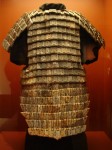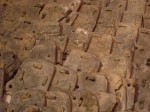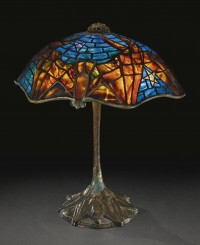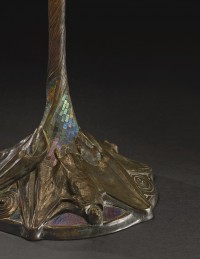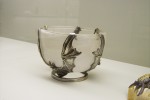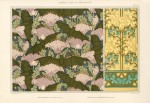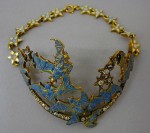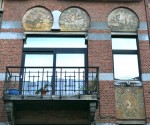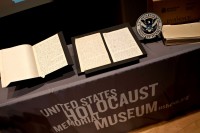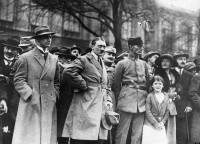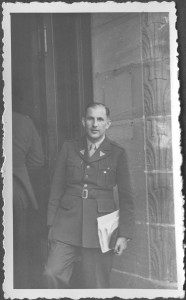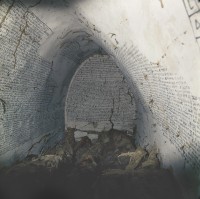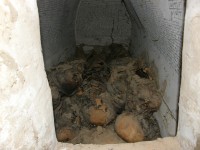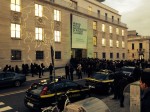 The Riace Bronzes, the pristine pair of 5th century B.C. Greek bronze warriors discovered off the coast of Calabria, the toe of Italy’s boot, in 1972, have gone back on public display after an involuntary hiatus of four years. At 4:30 PM Italian time, Culture Minister Massimo Bray officially opened the doors of the Palazzo Piacentini, home of the National Museum of Reggio Calabria, allowing the invited guests to view the splendid Bronzes, vertical again for the first time since 2009. The doors will open to the general public tomorrow.
The Riace Bronzes, the pristine pair of 5th century B.C. Greek bronze warriors discovered off the coast of Calabria, the toe of Italy’s boot, in 1972, have gone back on public display after an involuntary hiatus of four years. At 4:30 PM Italian time, Culture Minister Massimo Bray officially opened the doors of the Palazzo Piacentini, home of the National Museum of Reggio Calabria, allowing the invited guests to view the splendid Bronzes, vertical again for the first time since 2009. The doors will open to the general public tomorrow.
 The museum building was designed in the late 1930s by Fascist favorite architect Marcello Piacentini and was in fairly good condition but needed extensive renovations to expand and modernize the space and update the facilities and technology. The Bronzes are world-class artifacts, unique and famous all over the globe. A lot of work was necessary to make the Palazzo Piacentini suitable for the crowds of people who would visit the statues if they could. It was also in desperate need of anti-seismic retrofits to ensure the safety of its precious contents in a city that has been virtually leveled by earthquakes at least a half-dozen times since antiquity.
The museum building was designed in the late 1930s by Fascist favorite architect Marcello Piacentini and was in fairly good condition but needed extensive renovations to expand and modernize the space and update the facilities and technology. The Bronzes are world-class artifacts, unique and famous all over the globe. A lot of work was necessary to make the Palazzo Piacentini suitable for the crowds of people who would visit the statues if they could. It was also in desperate need of anti-seismic retrofits to ensure the safety of its precious contents in a city that has been virtually leveled by earthquakes at least a half-dozen times since antiquity.
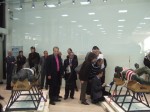 To make way for the refurbishment, in 2009 the Riace Bronzes were removed from their bases and gingerly transported to the nearby Palazzo Campanella (see the video in this entry for footage of the painstaking transportation process), seat of the Regional Council of Calabria, where they were placed on their backs in a climate-controlled glassed-in space. There experts were able to take advantage of the opportunity to study, test and conserve the statues. That opportunity was only supposed to be two years long, but budgetary problems and a million other delays got in the way of the museum’s renovation. While Palazzo Piacentini continued to be indisposed, the Bronzes, Reggio Calabria’s greatest tourist draw, were indisposed along with it.
To make way for the refurbishment, in 2009 the Riace Bronzes were removed from their bases and gingerly transported to the nearby Palazzo Campanella (see the video in this entry for footage of the painstaking transportation process), seat of the Regional Council of Calabria, where they were placed on their backs in a climate-controlled glassed-in space. There experts were able to take advantage of the opportunity to study, test and conserve the statues. That opportunity was only supposed to be two years long, but budgetary problems and a million other delays got in the way of the museum’s renovation. While Palazzo Piacentini continued to be indisposed, the Bronzes, Reggio Calabria’s greatest tourist draw, were indisposed along with it.
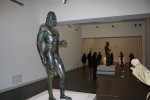
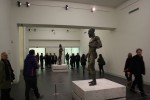 In their newly renovated hall, the statues now stand on new anti-seismic pedestals which anchor the statues to the floor even as they allow them to move by balancing the floor the Bronzes stand on over four spheres of marble. A system of counterweights ensures the statues will be able to remain standing on their pedestals should an earthquake strike. A handsome Carrara marble casing surrounds the pedestal.
In their newly renovated hall, the statues now stand on new anti-seismic pedestals which anchor the statues to the floor even as they allow them to move by balancing the floor the Bronzes stand on over four spheres of marble. A system of counterweights ensures the statues will be able to remain standing on their pedestals should an earthquake strike. A handsome Carrara marble casing surrounds the pedestal.
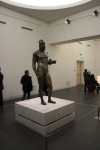
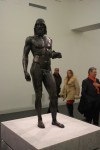 Their idealized musculature is set off to its best advantage by a new lighting system and the reopening of windows that had been bricked up years ago. A state-of-the-art climate control and air filtration system ensures that the many artifacts from Magna Graecia (Greater Greece, the collective term for Greece’s southern Italian colonies) on display in the museum and in particular the Riace Bronzes are kept free of contaminants and in proper climactic conditions.
Their idealized musculature is set off to its best advantage by a new lighting system and the reopening of windows that had been bricked up years ago. A state-of-the-art climate control and air filtration system ensures that the many artifacts from Magna Graecia (Greater Greece, the collective term for Greece’s southern Italian colonies) on display in the museum and in particular the Riace Bronzes are kept free of contaminants and in proper climactic conditions.
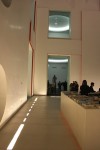 Other changes to the museum building include the addition of a roof restaurant with a beautiful view of the Straits of Messina, a new great hall for temporary exhibitions, a conference hall, a library and an underground level for storage of artifacts. The internal courtyard just beyond the entrance doors has been topped with a glass roof over an airy steel structure (it’s the first tensegrity roof in Italy) to create a new lobby from which visitors can see the Bronzes in their dedicated hall in the distance. They’ll get to see them up close in all their glory at the end of the route through the museum.
Other changes to the museum building include the addition of a roof restaurant with a beautiful view of the Straits of Messina, a new great hall for temporary exhibitions, a conference hall, a library and an underground level for storage of artifacts. The internal courtyard just beyond the entrance doors has been topped with a glass roof over an airy steel structure (it’s the first tensegrity roof in Italy) to create a new lobby from which visitors can see the Bronzes in their dedicated hall in the distance. They’ll get to see them up close in all their glory at the end of the route through the museum.
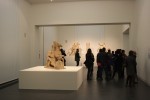 The renovation isn’t quite finished yet. Work on the roof, the conference hall and some of the other new spaces continues. The complete museum is expected to be open for business in April of next year, but considering that this was all supposed to be finished in 2011 in time for the 150th anniversary celebrations of the unification of Italy, I’d take that date with a grain of salt. At least the Riace Bronzes and many of the other ancient treasures of the museum are back in public view where they belong. As recently as last month the talk was they wouldn’t be back until the new year at the earliest.
The renovation isn’t quite finished yet. Work on the roof, the conference hall and some of the other new spaces continues. The complete museum is expected to be open for business in April of next year, but considering that this was all supposed to be finished in 2011 in time for the 150th anniversary celebrations of the unification of Italy, I’d take that date with a grain of salt. At least the Riace Bronzes and many of the other ancient treasures of the museum are back in public view where they belong. As recently as last month the talk was they wouldn’t be back until the new year at the earliest.
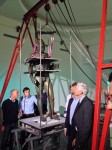 It’s all the more important that these masterpieces of Early Classical Greek art have a permanent, stable home because the odds of them traveling again are basically nil. They are so delicate, especially in the solder joints, that any movement at all is a major risk to their integrity. Both warriors have braces on their left arms, the ones bent at the elbow that probably once held spears, to relieve the stress on the joints. When the Bronzes were moved from the Palazzo Campanella two weeks ago, it took one hour to transport them less than a half a mile. Extrapolate that speed, and they would have to leave now to make it to Milan by 2015.
It’s all the more important that these masterpieces of Early Classical Greek art have a permanent, stable home because the odds of them traveling again are basically nil. They are so delicate, especially in the solder joints, that any movement at all is a major risk to their integrity. Both warriors have braces on their left arms, the ones bent at the elbow that probably once held spears, to relieve the stress on the joints. When the Bronzes were moved from the Palazzo Campanella two weeks ago, it took one hour to transport them less than a half a mile. Extrapolate that speed, and they would have to leave now to make it to Milan by 2015.
Not that Reggio would let them go even if they could. The region has hard a time of it lately, between the economy and the struggle against the pervasive ‘Ndrangheta organized crime syndicate (last fall the entire Reggio city council was dismissed for suspicion of ‘Ndrangheta infiltration), and the return of the Riace Bronzes is seen as a rebirth of Reggio and of Calabria as a whole, a fresh start with a focus on the regions rich cultural patrimony bringing in much-needed tourist revenue.

